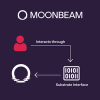Understanding Wallets On Moonbeam: How Moonbeam Bridges Ethereum and Substrate APIs
May 29, 2025
8 min read
Share

One of the main benefits of blockchains is that they give users direct control over their digital assets, eliminating the need for centralized intermediaries like banks or payment providers. This decentralization marks a foundational shift in how value is stored, transferred, and trusted online. Moreover, it can enable users to interact with a global, tamper-resistant “computer” (the blockchain itself) where smart contracts operate as autonomous programs that execute predefined tasks without human intervention or third-party oversight.
A key part of this journey is blockchain wallets. These wallets act as digital keys that allow users to access and control their assets on the blockchain. They are also the interface between users and the autonomous programs they interact with. Unlike in traditional systems, where a third party holds your funds (banks) or data (end-user applications), in blockchain-based systems, a blockchain wallet gives the user full custody and control over their interactions.
Whether it’s storing digital assets, interacting with decentralized applications (dApps), or signing secure transactions, wallets are the gateway to blockchain-based ecosystems, via an application programming interface (API) that they provide.
Moonbeam (and Moonriver) supports two distinct APIs for wallet interactions: the Ethereum API and the Substrate API. Let’s explore the key differences between them.
Substrate and Ethereum APIs
Moonbeam leverages one of the core components of the Polkadot SDK framework: Substrate. Substrate allows developers to build blockchains using modular components called pallets, where each pallet provides specific functionality. On Moonbeam, for example, there are separate pallets for staking, governance, and balance transfers.
Substrate also provides a standardized interface (or API) that enables wallets to interact with Substrate-based blockchains. This API allows users to invoke the functions exposed by each pallet, for instance, staking tokens through the staking pallet or voting on referenda via the governance pallet. As a result, whenever users engage with these core blockchain functions, they are interacting through the Substrate API.

In addition to Substrate functionality, Moonbeam offers full Ethereum and EVM compatibility.Go to page [object Object] This means developers can deploy smart contract applications using the same tools and workflows they would on any EVM-compatible blockchain, with no changes required. This is achieved through a combination of specialized pallets and the integration of an Ethereum-compatible API. Consequently, tools (including wallets) that are built to interface with Ethereum-based networks can interact seamlessly with Moonbeam as well.
Thus, when a user interacts with a smart contract-based application on Moonbeam (such as StellaSwap, Moonwell, or EvrLoot) they are doing so via the Ethereum API. These applications are built using the Ethereum development stack, and the interactions occur through the familiar Ethereum interface, ensuring compatibility with popular tools and wallets in the Ethereum ecosystem.

At first glance, you might assume that staking or voting in on-chain governance on Moonbeam would be off-limits when using Ethereum-enabled wallets. After all, those actions are tied to Substrate functionality, not the EVM.
Meet Moonbeam’s precompiled contracts, a special set of smart contracts that expose key Substrate functionality through the Ethereum API. These precompiles behave like regular smart contracts from the perspective of Ethereum-enabled wallets and applications. But, under the hood, they act as translators. Each call made through the Ethereum API to a specific precompile is mapped to a specific function in a specific Substrate pallet, allowing users to perform actions like staking or voting without ever leaving the EVM environment.

Ethereum Wallets
Now that we understand how Ethereum wallets can work with Moonbeam, let's go through some of the most frequently used wallets and how you can use it to interact with Moonbeam.
In short, Ethereum wallets can support Moonbeam/Moonriver either natively, or by adding them as custom networks with the following details:
- Network name: Moonbeam / Moonriver
- RPC URL: https://rpc.api.moonbeam.networkGo to page [object Object] / https://rpc.api.moonriver.moonbeam.networkGo to page https://rpc.api.moonriver.moonbeam.network
- Chain ID: 1284 / 1285
- Token symbol: GLMR / MOVR
- Block explorer: https://moonscan.ioGo to page [object Object] / https://moonriver.moonscan.ioGo to page https://moonriver.moonscan.io
MetaMask
MetaMask is one of the most popular Ethereum wallets and is fully compatible with Moonbeam and Moonriver via the Ethereum API. Users can add Moonbeam or Moonriver as a custom network using the RPC details provided, enabling them to interact seamlessly with EVM-based dApps, sign transactions, and manage GLMR or MOVR tokens. Thanks to Moonbeam’s precompiles, MetaMask users can also perform actions traditionally reserved for Substrate wallets, such as staking and governance, without leaving the Ethereum interface.
You can follow this tutorialGo to page https://docs.moonbeam.network/tokens/connect/metamask/ to get started with using Metamask on Moonbeam.
Ledger
Ledger is a hardware wallet that offers cold storage and top-tier security for crypto assets, including GLMR and MOVR. When used with MetaMask or any other wallet that supports it, Ledger can be connected to Moonbeam or Moonriver by configuring the custom network, enabling secure signing of transactions on EVM-based applications. While Ledger itself doesn’t directly interact with Substrate APIs, it can still access key Substrate functions on Moonbeam through MetaMask and the Ethereum API, including staking and governance via precompiled contracts.
You can follow this tutorialGo to page https://docs.moonbeam.network/tokens/connect/ledger/ethereum/ to get started with using Ledger on Moonbeam.
Trezor
Trezor provides secure offline storage and key management, and like Ledger, it can be used with Ethereum-compatible interfaces such as MetaMask to access Moonbeam and Moonriver. After setting up the custom RPC for these networks, users can use their Trezor device to interact with EVM-based dApps and manage their assets safely. Substrate-specific functions are also available through precompiles, allowing Trezor users to participate in staking and governance using Ethereum-compatible workflows.
You can follow this tutorialGo to page https://docs.moonbeam.network/tokens/connect/trezor/ to get started with using Trezor on Moonbeam.
Coinbase Wallet
Coinbase Wallet supports EVM-compatible chains and can be connected to Moonbeam and Moonriver by manually adding them as custom networks. It allows users to hold and manage GLMR or MOVR, interact with dApps, and sign transactions directly from a mobile or browser extension interface. While Coinbase Wallet lacks native support for Substrate APIs, Moonbeam’s Ethereum precompiles make it possible to perform Substrate-based functions like staking within the familiar EVM environment.
You can follow this tutorialGo to page https://docs.moonbeam.network/tokens/connect/coinbase-wallet/ to get started with using Coinbase Wallet on Moonbeam.
Substrate Wallets
Substrate wallets tend to support both Moonbeam and Moonriver natively, with no extra configuration required. In addition, most of them also offer access to Moonbeam's Ethereum API, so you can benefit from both worlds through a single wallet interface.
Nova Wallet
Nova Wallet is a mobile-first wallet designed specifically for the Polkadot ecosystem, offering native support for Substrate-based chains like Moonbeam and Moonriver. It provides full access to staking, governance, and other core blockchain functionalities through the Substrate API. Nova’s intuitive interface makes it easy to manage parachain assets, participate in referenda, and interact with Moonbeam-native features that are not accessible via EVM-only wallets.
Talisman
Talisman is a browser extension wallet tailored for the Polkadot and Kusama ecosystems, with native Substrate support. It allows users to manage GLMR and MOVR, stake tokens, vote on governance proposals, and interact directly with Moonbeam’s runtime modules via the Substrate API. While it also supports basic EVM functionality, its strength lies in enabling seamless access to all Substrate-native capabilities Moonbeam offers.
SubWallet
SubWallet is a versatile wallet that bridges both Ethereum and Substrate worlds, making it particularly well-suited for interacting with Moonbeam. It supports both Substrate API for staking and governance, and Ethereum API for EVM-based dApps, offering users a unified interface for all aspects of the Moonbeam ecosystem. This dual support makes SubWallet a powerful all-in-one tool for managing assets and interacting with smart contracts and on-chain functions alike.


